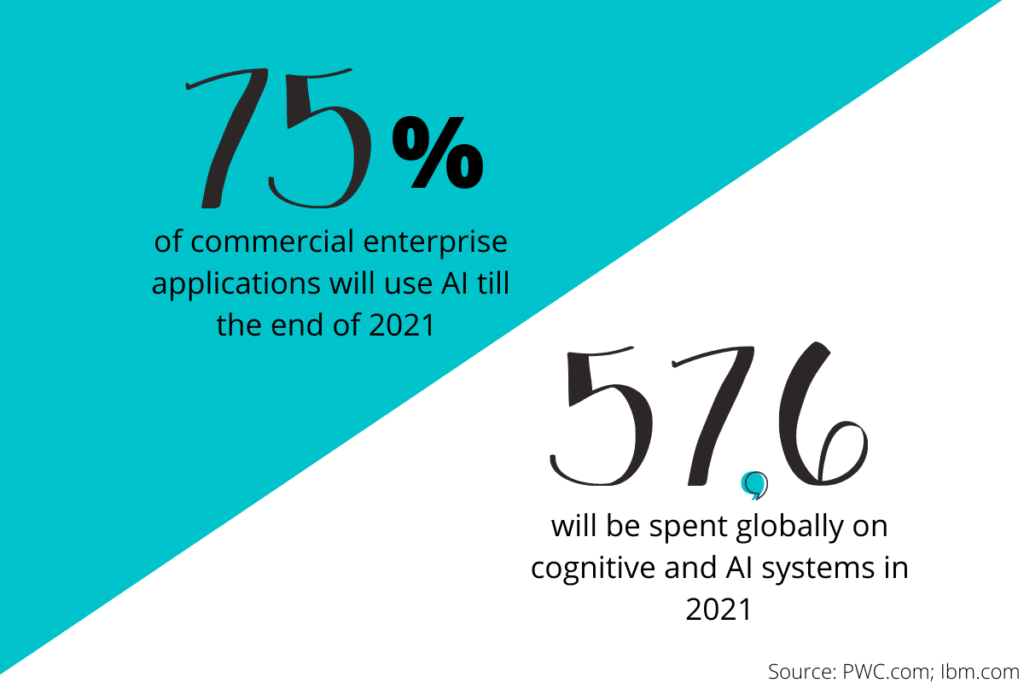Important things to make sure your AI project is viable
November 12th, 2020
Any project that deals with creating an AI proof of concept for clients begin with a series of questions. These questions allow the clients to understand if their business is suited and ready for this time of technology to be helpful to them.
While the implementation of AI into your business could be found to be viable on a strategic front, as well as being compliant with any relevant rules and regulations of your particular industry, it is important to evaluate if it is viable technically and if it makes financial sense.
This article will look into what you will want to consider when making AI project-related decisions and will provide a detailed guide on how to start building your AI project successfully.
Some Important Numbers First
According to Gartner, Inc.’s 2019 study implementation of AI expanded by 270% in the four years before it, and tripled in 2018. The market for global AI at the time of the study (2019) was valued at 27.23 billion. According to Forbes Business Insider, It is projected to reach 266.92 billion by 2027.
By the end of 2021, it is expected that 75% of all commercial enterprise applications will utilize AI, rounding to approximate annual spending of 5.7.6 billion dollars.
TechRepublic recently conducted a survey that found that 90% of companies are actively working on AI-related projects. However, only a third of those projects are actually successful, and it is likely due to the neglect of some organization to perform some fundamental steps.

I. Focus On The Right Business Case
It is not enough to just have AI as part of your system. You need it to provide a solution to a problem or an answer to some dilemma. Many companies jump into AI projects without clearly defining what the AI’s intent is and what hardship its use aims to alleviate. If what you need to achieve can be done without implementing AI, your current system might be well suited to take care of your needs for you.
It could also be that the problem you are dealing with is too complex for an AI solution. While AI is immensely powerful and capable, it is not magical, even if certain industries paint it as such. The key to succeeding with AI applications is setting realistic, achievable goals. These must be achievable given the technological state of the times.
II. AI Projects Are IT Projects
Because of the commonly misrepresented reputation of AI, many companies buy into its nonexistent magical properties and believe that it is separate from their other IT projects. In fact, the management processes already in place around the present information technology can leverage AI to work more efficiently.
AI should be evaluated for how much return on investment it provides as any other IT project would be. There are costs associated with the implementation and deployment of the AI model, therefore, as you would with any other IT project, it is important to build a financial model of AI’s operating costs.
III. Bridging The Gap Between Data Science And Business Teams
To truly leverage AI, a company needs to not just implement it into its production process but to use it to achieve set business goals, making it paramount that a company actually understands the needs of their business and can come to an agreement about the specifics of this aspect with data scientists. Trust can be forged between business units if the science team can move past the experimental phase, develop production models, and can deliver accurate, repeating predictions over a certain time period.
AI is not a blanket solution to all problems either, and its deployment, being a new kind of project for most teams will assure a learning curve. At its core, an AI project is an IT project, and it should be treated as such. That, of course, will mean that any best practices proven effective for other IT projects to apply to an AI endeavor like formulating goals and devising a clear vision with the understanding of why the change is needed. Ensuring that your organization comprised the project and that the team members of your data scientist team understand the important points of the project.
Achieving alignment, gaining support, and momentum for the project can create a state of urgency on both sides of the organization. You would and should rely on the years of best practices which have been an industry guide:
- The setting of clear goals, scope, and KPIs
- Organizing meetings to continuously coordinate and monitor the progress of the project
- Communicating project progress updates to a broader audience, including corporate management
IV. Viability Considerations
Is the problem at hand a viable candidate for an AI solution? What type of financial solution does it offer the business? Here are a few points to consider when thinking about the impact of this action:
- Will an AI solution produce operational savings or direct capital gains?
- Could an AI solution result in increased revenue?
- Can AI reduce/improve the quality of the product and reduce failure rates? If so, this could result in saving money, increasing market share, and producing more reliable output.
- Could an AI solution increase customer satisfaction and improve customer experience?
When all of the above factors are considered together, a clearer picture of a true return on investment can be seen. Our advice to our clients is to always consider those projects which will carry the greatest ROI potential for their business. Once it is determined that the introduction of AI will help the company boost its competitive edge in the market, as well as save a lot of money, we can’t wait to start digging into the technical aspect of how to create such a solution.
Some companies jump into a full technical audit but do so before all the necessary evaluations are done. We typically advise against doing so because we do not want companies to needlessly burn through their budget.
V. Technical Capability
If all of the previously described points are feasible, companies still need to consider that using AI translates to demanding more from their technical system. AI implementation will place a significantly higher analytical load on the current systems, so it is important to assure that the systems can handle it. If your current platform is not modern enough, you might need to potentially modernize it before AI yields much in the way of benefits to your process.
If you are interested in learning more about AI and machine learning, check out our AI and ML page here.
4 Necessary Stages Of The Technical End Of An AI project
- Programming Language: There are a few primary programming languages dealt with in AI projects. These are Python, Java, LISP, Prolog, and C++. Many factors can influence the language you choose including, but not limited to, the expected load of the AI project, business specifics, how new (or old) the product is, problems trying to be addressed, your ultimate goals, the market situation, and who your clients/users are. Some solutions need to leverage more than one language to achieve a maximum level of efficacy.
- Quality: The amount of knowledge possessed by the system will influence the quality of the result, so it must be represented in an efficient way. In saying so, the representation of said knowledge is pivotal to the system working as you need it to. There are multiple representation schemes including frames, scripts, conceptual dependencies, and associative (or semantic) networks.
- Hardware: The majority of AI programs will be implemented on Princeton designed Von Neumann machines. Recently, however, AI programming has been able to be performed on dedicated workstations as well. These computers fall into 4 categories:
a. SISD Machines (Single Instruction Single Data)
b. SIMD Machines (Single Instruction Multiple Data)
c. MISD Machines (Multiple Instruction Single Data)
d. MIMD Machines (Multiple Instruction Multiple Data) - Learning Agents: Four primary components make up a learning agent.
a. An action is chosen by the performance element. Subsequent actions are decided on the feedback to the new action and suggested improvements.
b. A critical element evaluates the action’s outcome, then provides necessary feedback.
c. The learning element receives the critic element’s feedback and uses that information to improve upon future actions.
d. A problem generator comes up with new scenarios that develop to be tested out by the learning agent. This permits the learning agent to continue to function.
Conclusion
By understanding and adopting these principles an organization does not need to lurch from one experiment to the next and instead be able to fully realize the value and merit of their AI models. AI is still new to most companies so refinements and experience planning will continue to strengthen the efficacy of AI platforms and strategies in the future.














